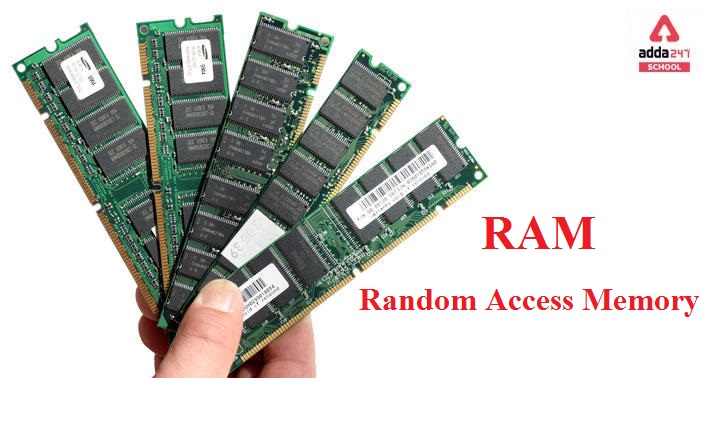RAM Full Form in Computer
RAM Full Form – RAM, the abbreviation stands for Random Access Memory in its complete form.
Other direct-access data storage media read and write data items with the time significantly depending on their physical locations on the recording medium. However, random-access memory or RAM allows data items to be read or written in almost the same amount of time, and that too regardless of their physical location inside the memory.
To connect the data lines to the addressed storage for reading or writing the entry, RAM contains multiplexing and demultiplexing circuitry.
RAM nowadays is in the form of integrated circuit chips containing metal-oxide-semiconductor memory cells. Now, non-volatile RAM has also been developed, but RAM has always been associated with volatile types of memory, where stored information is lost if power is removed.
RAM Full Form in Hindi ( RAM ka Full Form )
RAM का पूर्ण रूप रैंडम एक्सेस मेमोरी है। RAM का उपयोग डेटा को स्टोरेज में लिखने और पढ़ने के लिए किया जाता था। सीपीयू के सक्रिय होने पर रैम फाइलों और प्रोग्राम डेटा को स्टोर करता है। यह एक अस्थिर मेमोरी है क्योंकि बिजली बंद होने पर डेटा खो जाता है।
अन्य डायरेक्ट-एक्सेस डेटा स्टोरेज मीडिया के विपरीत, जहां डेटा आइटम को पढ़ने और लिखने के लिए आवश्यक समय रिकॉर्डिंग माध्यम, रैंडम-एक्सेस मेमोरी या रैम पर उनके भौतिक स्थानों के आधार पर काफी भिन्न होता है।
प्रविष्टि को पढ़ने या लिखने के लिए डेटा लाइनों को एड्रेस्ड स्टोरेज से जोड़ने के लिए, रैम में मल्टीप्लेक्सिंग और डीमल्टीप्लेक्सिंग सर्किटरी शामिल है।
RAM आमतौर पर अस्थिर प्रकार की मेमोरी से जुड़ा होता है, जहां बिजली हटा दिए जाने पर संग्रहीत जानकारी खो जाती।
RAM Full Form in Computer: A look at history!
Robert Dennard, was the first to discover RAM, which is today known as solid-state memory, in 1968. In DRAMs, transistors have been employed to preserve bits of data.
In 1947, the Williams tube was utilised to create the first type of RAM. Then the Cathode Ray Tube was employed, and information was stored in the form of electrical charge spots on the tube’s face. In the same year, 1947, magnetic-core memory became the second most widely utilised type of RAM.
Expand RAM full form and their categories
RAM (Random Access Memory) has been categorized further into two of the subtypes, namely;
- Static random-access memory (SRAM)
- Dynamic random-access memory (DRAM)
Static random-access memory (SRAM) and dynamic random-access memory (DRAM) are the two primary types of volatile random-access semiconductor memory (DRAM). IBM introduced the SP95 SRAM chip for their System/360 Model 95 computer in 1965, and Toshiba employed DRAM memory cells for its Toscal BC-1411 electronic calculator in 1966, both based on bipolar transistors. The Intel 1103, the first commercial DRAM IC device, was released in October 1970. In 1992, the Samsung KM48SL2000 microprocessor introduced synchronous dynamic random-access memory (SDRAM).
| CBSE Full Form | ICSE Full Form |
| CEO Full Form | SOP Full Form |
| AM PM Full Form | ACP Full Form |
FAQs on Ram Full form
What is the full form of RAM?
RAM, the abbreviation stands for Random Access Memory in its complete form.
What is the full form of ROM?
RoM, the abbreviation stands for Read Only Memory in its complete form.
What is the purpose of RAM?
The random access memory is one of the most significant components in influencing the performance of your system. RAM provides a temporary storage and access location for applications. It saves the information that your computer is now consuming so that it can be immediately accessible.
What is the difference between GB and RAM?
Random access memory (RAM) is a type of memory that can be accessed at any time. This is where a computer saves data before processing it. The amount of memory in RAM is measured in gigabytes (GB).
Which RAM is the fastest?
In comparison to dynamic RAM, static RAM is more expensive and requires four times the amount of space for the same amount of data, but it does not require power refresh and is thus faster to access.









 Karnataka SSLC Model Question Paper 2026...
Karnataka SSLC Model Question Paper 2026...
 CBSE Class 12th Geography Syllabus 2025-...
CBSE Class 12th Geography Syllabus 2025-...
 HBSE Date Sheet 2026 Soon, Check BSEH Cl...
HBSE Date Sheet 2026 Soon, Check BSEH Cl...

















